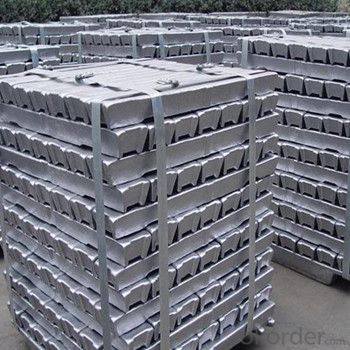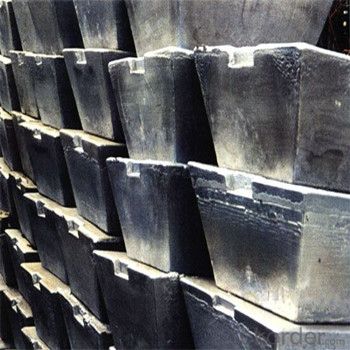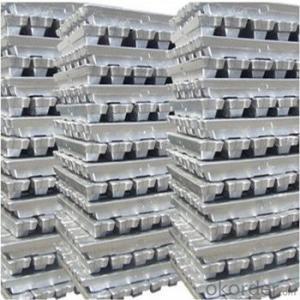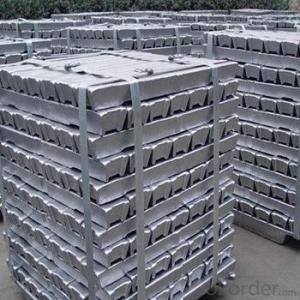Aluminium Ingot from Factory Wholesales Made in China
- Loading Port:
- China main port
- Payment Terms:
- TT OR LC
- Min Order Qty:
- 1000 m.t.
- Supply Capability:
- 10000 m.t./month
OKorder Service Pledge
OKorder Financial Service
You Might Also Like
Pure Aluminum Ingot Used for Industry
1.Structure of Aluminum Ingot Description
Aluminum Ingot is with the AL as the main chemical composition. Aluminum Ingot is used for industry,such as automobile,pinning and weaving,electron broadly and so on. Aluminum Ingot has the following advantages: easy control and operation, fast melting.
2.Main Features of the Aluminum Ingot
•High Purity
•Easy control and operation
•High strength
•Fast melting
•Competitive price
•Best Service
3. Aluminum Ingot Images


4. Aluminum Ingot Specification
Grade | Chemical Composition % | |||||||||
Al≥ | impurities ≤ | |||||||||
Si | Fe | Cu | Ga | Mg | Zn | Mn | others | Sum | ||
Al99.9 | 99.90 | 0.50 | 0.07 | 0.005 | 0.02 | 0.01 | 0.025 | - | 0.010 | 0.10 |
Al99.85 | 99.85 | 0.80 | 0.12 | 0.005 | 0.03 | 0.02 | 0.030 | - | 0.015 | 0.15 |
Al99.7 | 99.70 | 0.10 | 0.20 | 0.010 | 0.03 | 0.02 | 0.030 | - | 0.030 | 0.30 |
Al99.6 | 99.60 | 0.16 | 0.25 | 0.010 | 0.03 | 0.03 | 0.030 | - | 0.030 | 0.40 |
Al99.5 | 99.50 | 0.22 | 0.30 | 0.020 | 0.03 | 0.05 | 0.050 | - | 0.030 | 0.50 |
Al99.00 | 99.00 | 0.42 | 0.50 | 0.020 | 0.03 | 0.05 | 0.050 | - | 0.050 | 1.00 |
5.FAQ of Aluminum Ingot
We have organized several common questions for our clients,may help you sincerely:
①How about your company?
A world class manufacturer & supplier of castings forging in carbon steel and alloy steel,is one of the large-scale professional investment casting production bases in China,consisting of both casting foundry forging and machining factory. Annually more than 8000 tons Precision casting and forging parts are exported to markets in Europe,America and Japan. OEM casting and forging service available according to customer’s requirements.
②How to guarantee the quality of the products?
We have established the international advanced quality management system,every link from raw material to final product we have strict quality test;We resolutely put an end to unqualified products flowing into the market. At the same time, we will provide necessary follow-up service assurance.
③How long can we receive the product after purchase?
In the purchase of product within three working days, We will arrange the factory delivery as soon as possible. The pecific time of receiving is related to the state and position of customers.Commonly 7 to 10 working days can be served.
- Q: The difference between electrolytic aluminium, alumina and aluminium ingot
- You said, "the aluminum factory also needs bauxite," then the aluminum smelter is not necessarily a single electrolytic aluminum plant, there may be other production processes.
- Q: Can aluminum ingots be used in medical applications?
- Medical applications can utilize aluminum ingots effectively. Aluminum, known for its versatility and advantages in the medical field, offers lightweight properties, corrosion resistance, and excellent thermal conductivity. These qualities make it an optimal choice for a range of medical devices and equipment. Manufacturing medical devices like prosthetics, orthopedic implants, and surgical instruments can utilize aluminum ingots. These ingots can be precisely shaped and sized to meet specific requirements in medical applications. Furthermore, aluminum is commonly employed in the production of medical equipment such as MRI machines, X-ray machines, and dental tools. Moreover, aluminum ingots find use in the production of medical packaging materials. Aluminum foils, with their ability to act as a barrier against moisture, light, and oxygen, are ideal for packaging pharmaceutical products. This ensures the integrity and longevity of medications. It is crucial to emphasize that the utilization of aluminum in medical applications must adhere to strict regulations and guidelines to guarantee patient safety. Manufacturers must rigorously comply with quality control measures and conduct thorough testing to ensure the biocompatibility and safety of the final product. To conclude, aluminum ingots possess favorable properties that make them suitable for various medical applications. Nonetheless, it is essential to prioritize compliance with applicable regulations and standards to ensure the safety and effectiveness of the final medical product.
- Q: Our unit is aluminum smelting enterprise, mainly producing aluminum ingots. The unit adopts wet dedusting equipment, and the packing tower explodes!
- In the process of heating aluminum, when the temperature rises, the molten aluminum will produce tiny particles of atomic aluminum.
- Q: How many tons of alumina for a ton of aluminum ingot, alumina and electrolytic aluminum what is the difference?
- 1.889 tons of alumina contains a ton of metal aluminum. Or 1.889 tons of alumina can theoretically extract 1 tons of pure aluminum.
- Q: Production process of aluminium ingot
- The production of aluminum ingot is made up of bauxite mining, alumina production, aluminum electrolysis and other production links.First a bauxite mining, water washing, grinding and other processes to produce aluminum powder, alumina roasting by complex processes such as four by bauxite alumina production, there are three main types: gibbsite and diaspore, boehmite.
- Q: What are the properties of aluminum ingots?
- Aluminum ingots possess several distinct properties that make them highly valuable in various industries. First and foremost, aluminum ingots exhibit exceptional lightness, as they have a low density compared to other metals. This property makes them ideal for applications where weight reduction is crucial, such as in the aerospace and automotive sectors. Additionally, aluminum ingots possess excellent corrosion resistance, making them suitable for use in environments where exposure to moisture, chemicals, or harsh weather conditions is probable. This corrosion resistance is due to the formation of a thin, protective oxide layer on the surface of the ingot, which prevents further oxidation and deterioration. Another notable property of aluminum ingots is their high thermal conductivity, allowing them to efficiently transfer heat. This characteristic is particularly advantageous in heat exchange systems, where the ingots can facilitate the transfer of thermal energy. Moreover, aluminum ingots also exhibit excellent electrical conductivity, making them suitable for applications in the electrical and electronics industries. Furthermore, aluminum ingots have a high strength-to-weight ratio, making them strong yet lightweight. This property allows for the construction of structures that require both strength and durability without compromising on weight. Moreover, aluminum ingots are easily recyclable, retaining their properties even after multiple recycling processes, which makes them an environmentally friendly choice. Overall, the properties of aluminum ingots, including their lightness, corrosion resistance, thermal and electrical conductivity, high strength-to-weight ratio, and recyclability, contribute to their widespread use in various industries, ranging from transportation and construction to packaging and consumer goods.
- Q: What is the role of aluminum ingots in the production of cans?
- The production of cans relies heavily on aluminum ingots, which serve as the primary raw material in the manufacturing process. These ingots are melted and then shaped into the desired size and form of the can. Aluminum is the chosen material for cans due to its exceptional properties. Its lightweight nature makes transportation and handling easier. Additionally, it is highly durable and resistant to corrosion, ensuring the cans effectively safeguard their contents. After the aluminum ingots are melted and shaped, they undergo several processes to transform into the final can. This involves shaping, forming, and coating to ensure strength and withstand the pressure exerted by carbonated beverages. Moreover, aluminum ingots enable convenient recycling of cans. Aluminum is a highly recyclable material, and incorporating ingots in the production process guarantees that cans can be recycled and reused multiple times without compromising quality. In conclusion, aluminum ingots play a crucial role in can production, providing the essential raw material for lightweight, durable, and recyclable containers extensively used in the beverage industry.
- Q: What are the common uses of aluminum ingots?
- Aluminum ingots have a wide range of common uses due to their unique properties. One of the most common uses is in the manufacturing of various products in the automotive industry. Aluminum ingots are used to make engine components, such as cylinder heads and engine blocks, as well as body panels and wheels. The lightweight nature of aluminum makes it ideal for improving fuel efficiency and reducing vehicle weight. Another prominent use of aluminum ingots is in the construction industry. Aluminum is used to fabricate window frames, door frames, roofing materials, and structural elements. It is highly corrosion-resistant, which makes it suitable for outdoor applications. Additionally, its lightweight nature allows for easy installation and transportation. The packaging industry also heavily relies on aluminum ingots. Aluminum is used to make cans for beverages and food items due to its excellent barrier properties, which protect the contents from light, moisture, and air. Moreover, aluminum cans are easily recyclable, making them a sustainable choice. Aluminum ingots are also widely used in the electrical industry. They are utilized in the production of power transmission lines, electrical wiring, and conductors. Aluminum's high electrical conductivity and low weight make it an ideal material for conducting electricity efficiently and cost-effectively. Lastly, aluminum ingots find applications in the aerospace industry. The lightweight yet strong characteristics of aluminum make it an excellent choice for manufacturing aircraft components, including wings, fuselages, and structural parts. The weight reduction achieved with aluminum significantly improves fuel efficiency and overall performance. Overall, the common uses of aluminum ingots span across various industries, including automotive, construction, packaging, electrical, and aerospace. Its versatility, strength, and lightweight nature make it an essential material in modern manufacturing processes.
- Q: What are the health risks associated with working with aluminum ingots?
- The health risks associated with working with aluminum ingots include inhalation of aluminum particles or fumes, which can lead to respiratory issues such as coughing, shortness of breath, and lung damage. Prolonged exposure may also increase the risk of developing lung diseases like asthma or bronchitis. Additionally, handling aluminum ingots without proper protective equipment may result in skin irritation or allergic reactions. It is crucial to follow safety guidelines and use appropriate personal protective equipment to minimize these risks.
- Q: How can the sustainability practices in aluminum ingot production be enhanced?
- There are multiple ways to enhance sustainability practices in the production of aluminum ingots. To begin with, the environmental impact of the production process can be significantly reduced by adopting cleaner and more energy-efficient technologies. This could involve utilizing renewable energy sources like solar or wind power to operate the production facilities. Upgrading equipment and machinery to more energy-efficient models can also help lower energy consumption and minimize greenhouse gas emissions. Another effective approach is to optimize the recycling and reuse of aluminum scrap and waste materials. This can greatly reduce the need for producing new aluminum. By implementing efficient recycling programs and investing in advanced recycling technologies, a higher percentage of aluminum can be recovered from end-of-life products and reintroduced into the production process. This not only conserves valuable resources but also reduces the energy-intensive extraction and refining processes associated with primary aluminum production. Improving water management practices is also crucial for enhancing sustainability in aluminum ingot production. Implementing measures such as recycling and reusing water within the production process can help minimize water consumption. Additionally, installing wastewater treatment systems to remove pollutants and contaminants from discharged water can prevent water pollution and protect local ecosystems. Furthermore, sustainability in aluminum production can be enhanced by promoting transparency and responsible sourcing practices in the supply chain. This involves ensuring that raw materials like bauxite and alumina are obtained from responsible and sustainable mining practices. Implementing traceability systems and certification programs can help verify the origin and sustainability of these materials, ensuring compliance with ethical and environmental standards. Lastly, engaging with various stakeholders, including employees, local communities, and industry associations, is essential for fostering a culture of sustainability and driving continuous improvement in aluminum ingot production. This can be achieved through regular training and awareness programs on sustainable practices, as well as collaborating with suppliers and customers to identify and implement innovative sustainability solutions. Overall, enhancing sustainability practices in aluminum ingot production requires a comprehensive approach that encompasses technological advancements, efficient resource management, responsible sourcing, and stakeholder engagement. By implementing these measures, the aluminum industry can reduce its environmental impact and contribute to a more sustainable future.
Send your message to us
Aluminium Ingot from Factory Wholesales Made in China
- Loading Port:
- China main port
- Payment Terms:
- TT OR LC
- Min Order Qty:
- 1000 m.t.
- Supply Capability:
- 10000 m.t./month
OKorder Service Pledge
OKorder Financial Service
Similar products
Hot products
Hot Searches



























